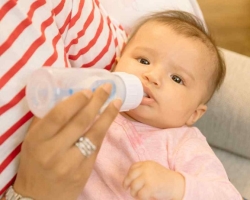The first teeth in a child is an undoubtedly long -awaited and significant event. But, before you feel this joy, your baby will have to go through a rather stressful stage - the stage of teething.
Content
- When to wait for the first tooth in the baby?
- Desna when teething in children
- Symptoms of teething in a child
- Museum teeth scheme in children and the procedure for their teething
- How to help a child when tearing milk teeth?
- Do you need care for milk teeth?
- Diseases of milk teeth
- When to lead the child to the dentist?
- How to prevent milk teeth?
- Change of milk teeth or when do you have teeth in children?
- Conditions for beautiful permanent teeth
- Video: First teeth. School of Dr. Komarovsky
When to wait for the first tooth in the baby?
Doctors noted cases when the baby has one or two teeth at birth. If your child is not one of these children, then you should know at what age the child has the first teeth. You will see the first tooth when the baby will be 6-8 months. Deviations are possible for several months in both directions. Do not panic if the first tooth appears in 4 or 10 months.
Important: but at least one tooth should be cut out for a one -year -old child. Otherwise, the child needs to be shown to a specialist in order to exclude serious problems in the body.
Desna when teething in children
Before you appear, the tooth overcomes bone tissue and mucous membrane of the gums. This long way affects the state of the gums.
First, the gum swells and blushes. But mothers may not distinguish the swollen gum from ordinary. Often this stage is generally unnoticed.
When you see that a certain white speck will be seen through the gum, then in the next two weeks a tooth will appear out.

If you do not miss the moment, until the tooth appears, you will see a small strip on the gum.

After this moment, the next morning, most likely, you will see the tooth itself.

Symptoms of teething in a child
Teething of teeth can lead to the following symptoms:
- the irritability and tearfulness of the child;
- bad sleep;
- more frequent application to the chest;
- the appearance of a runny nose;
- a slight increase in temperature is up to 37.5 degrees.
But do not begin to worry ahead of time, because many mothers can boast of an absolutely invisible and easy teething of teeth in a child.
Important: the temperature is above 37.5, diarrhea, vomiting, lack of appetite, the general weakness of the child cannot be symptoms of teething. If you have them, you should urgently show the child to the doctor.
Museum teeth scheme in children and the procedure for their teething
By the age of 3 years, your baby should have 20 milk teeth.

The teething dates are quite arbitrary. If the first tooth of your baby was cut off late, then the indicated schedule of teething of the rest can be moved forward.
The order can also be violated. Although sometimes this may indicate the development of diseases such as rickets, for example.
Important: if the teething periods differ from those indicated more than three months, and the order does not correspond to it absolutely, show the child to the doctor.
How to help a child when tearing milk teeth?
The teething process is very painful. In situations where he is very worried about the child, you need to try to help him. Here are several ways:
- teethers for teeth. The painful sensations are a little soothing, carrying out a kind of massage. However, not all children love to bite them;
- desna massage. With clean fingers, you can slightly massage the gums. Do not press on the gum hard so as not to damage;
- anesthetic agents. They are in the form of gel, pastes, pills. Gels and pastes are applied to the gums when the child hurts. Their downsides are that they are quickly washed off with saliva and often cause allergies. Tablets are made on the basis of herbs. They can be taken systematically, according to the instructions. The effect of tablets lasts longer.
Important: do not forget that to take painkillers only if necessary, because this is a medicine.
Do you need care for milk teeth?
Important: care is necessary. You should start the care of milk teeth after the appearance of the first tooth.
For children under a year, you can clean two ways once a day:
- wind up a gauze or bandage on a previously washed finger on a previously washed finger;
- put a special rubber cap for brushing your teeth on the finger of an adult and brush.
After a year, buy a child’s toothbrush corresponding to age.
It is necessary to clean twice a day: In the morning after breakfast and in the evening before bedtime. Change the brush every 3 months.
Brush your teeth must be moved from the gums from the bottom up (for the lower teeth) or from top to bottom (for the upper teeth).
Diseases of milk teeth
The most common disease of milk teeth is caries. The enamel of the milk teeth is highly subject to external influences. Caries is one of the consequences of this.
In addition to caries, there are sometimes other diseases:
- paradontitis. Leads to early loss of milk teeth. It occurs with weakened immunity of the child;
- periodontitis is the most frequent complication of caries. Entails serious and prolonged treatment;
- pulpitis. It is also a complication of caries ignored. It often proceeds asymptomatic.
Important: as you can see, you are not always able to detect a disease of the child’s teeth. Therefore, be sure to take the child to the dentist twice a year.
When to lead the child to the dentist?
Parents need to systematically monitor the state of the child’s milk teeth.
If you find any of these signs in a child, you need to contact a children's dentist:
- white, brown or black spots on tooth enamel;
- the tooth hurts when the child is chewing. You may notice that the baby is trying to chew on one side;
- the child feels special discomfort when he eats sweet, sour, salty, cold, hot;
- strong toothache. The child is capricious and refuses to eat.

How to prevent milk teeth?
Important: in addition to brushing your teeth, follow the following simple rules:
- adults should not lick children's nipples and spoons. Your bacteria to nothing to your baby;
- limit your child in eating sweets. Sweet drinks will also cause harm at night or at night;
- tleas a child under two years old to drink a few sips of pure water after eating. The baby from two years learn to rinse your teeth after eating;
- visit the dentist regularly;
- tear the child to fall asleep with a bottle in the mouth;
- try to prevent the enamel's mechanical injuries.
Change of milk teeth or when do you have teeth in children?
The beginning of the change of milk teeth falls on the age of 5-7 years. The order is approximately the same as when tearing the milk teeth. But when the permanent teeth are rejected, another 8-12 teeth are added, which the child did not have before.
At first, teeth appear, which before there were no - the first molars. This happens at 6-7 years old. Next, there is a replacement of incisors (6-9 years). At 9-12, the first premolars, the second premolar and fangs are changing. Well, the emergence of the second premolars (11-12 years old) and third premolars, called the teeth of “wisdom” (17-25 years), completes the process of teething of permanent teeth.

Important: these terms are also arbitrary, as in the teething of milk teeth.
Conditions for beautiful permanent teeth
By the time of the appearance of permanent teeth, gaps should form between the milk of the child’s milk teeth due to the active growth of the jaw. These gaps are needed so that constant teeth, which are much larger than milk in size, have enough space. Otherwise, the tooth will come out crookedly or will be less than necessary. In more complex cases, the tooth may be outside the dentition.
Important: if there are no gaps between milk to the dairy teeth by the time of teething, be sure to contact a children's orthodontist. Perhaps the problem can be solved at an early stage of occurrence.
As you can see, teething is a natural process. But parents should still know more about this process in order to avoid problems with the baby’s teeth in the future.







